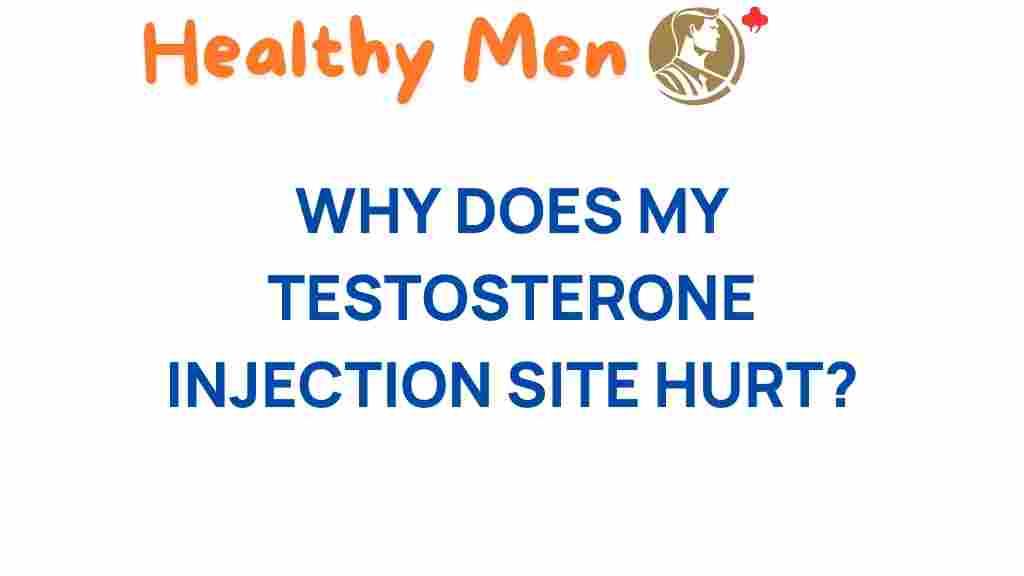Unraveling the Mystery: Why Does My Testosterone Injection Site Hurt?
Testosterone injections are a common method for hormone replacement therapy, especially for individuals with low testosterone levels. While these injections can significantly improve health and wellness, many patients report discomfort at the injection site. This article aims to explore the reasons behind injection pain, its side effects, and what you can do to alleviate discomfort. Understanding the underlying issues can provide insight into managing your health and wellness effectively.
Understanding Testosterone and Its Role in Health
Testosterone is a crucial hormone in both men and women, playing a vital role in various bodily functions. It helps in:
- Maintaining muscle mass
- Regulating libido
- Supporting bone density
- Enhancing mood and cognitive function
When testosterone levels drop, individuals may experience a range of symptoms, including fatigue, depression, and decreased sexual function. Testosterone replacement therapy (TRT) can restore these levels, but it’s essential to understand the potential side effects, including injection pain.
The Basics of Testosterone Injections
Testosterone injections are typically administered intramuscularly or subcutaneously. Common sites for intramuscular injections include the thigh (vastus lateralis) and the gluteus maximus, while subcutaneous injections are often given in the abdomen or thigh. Despite the benefits, patients often report varying degrees of pain or discomfort at the injection site.
Why Does My Testosterone Injection Site Hurt?
Injection pain can be attributed to several factors, including:
1. Injection Technique
The technique used during the injection can significantly affect pain levels. Improper technique, such as injecting too quickly or at the wrong angle, can lead to increased discomfort. Ensuring proper training and technique is crucial for minimizing pain.
2. Needle Size and Type
The size and type of needle used for the injection can also contribute to pain. Larger needles can cause more tissue trauma, leading to soreness. Using a smaller gauge needle may help reduce injection pain.
3. Injection Site
Different injection sites may have varying levels of sensitivity. Muscles and fatty tissues can react differently to injections, and some areas may be more prone to pain. Rotating injection sites can help mitigate discomfort.
4. Solution Viscosity
The viscosity of the testosterone solution can impact how easily it is injected and how much pain is experienced. More viscous solutions may cause more tissue trauma, leading to increased soreness post-injection.
5. Allergic Reactions
Some individuals may experience localized allergic reactions to the testosterone or the carrier oil in which it is suspended. Symptoms may include redness, swelling, and pain at the injection site. If you suspect an allergy, consult your healthcare provider for alternative options.
6. Infection
While rare, infections can occur at the injection site, leading to pain, swelling, and redness. If you notice any signs of infection, such as fever or pus discharge, seek medical attention immediately.
Managing Injection Pain
There are several strategies to help manage and reduce injection pain:
1. Proper Injection Technique
- Ensure you are trained in injection technique or have a healthcare provider administer the injection.
- Inject slowly and at a 90-degree angle for intramuscular injections or a 45-degree angle for subcutaneous injections.
2. Use a Smaller Needle
If possible, discuss with your healthcare provider about using a smaller gauge needle for your injections.
3. Rotate Injection Sites
Rotating between different injection sites can prevent tissue damage and reduce pain. Keep a log of your injection sites to ensure you are not injecting into the same spot too frequently.
4. Warm the Injection Site
Applying a warm compress to the injection site before and after the injection can help relax the tissue and reduce pain.
5. Ice the Area
After an injection, applying ice can help numb the area and reduce swelling. Use ice for about 15-20 minutes post-injection.
6. Over-the-Counter Pain Relief
If necessary, consider using over-the-counter pain relief medications like ibuprofen or acetaminophen to manage discomfort. Always consult your healthcare provider before taking any medications.
When to Seek Medical Advice
While some pain and discomfort are common after testosterone injections, certain symptoms warrant medical attention:
- Severe pain that does not improve with home care
- Signs of infection (redness, swelling, warmth, fever)
- Allergic reactions (hives, difficulty breathing)
- Persistent swelling or lumps at the injection site
If you experience any of these symptoms, it’s crucial to consult your healthcare provider for further evaluation and treatment.
Conclusion
Understanding the reasons behind testosterone injection pain is essential for effective patient care and wellness. By recognizing potential causes and implementing strategies to manage discomfort, individuals can experience a more positive and beneficial hormone replacement therapy journey. Remember, always consult your healthcare provider for personalized medical advice tailored to your specific health needs.
For additional resources on hormone therapy and wellness, consider visiting this link. It’s important to stay informed and proactive in your health journey.
If you have further questions or need more information, don’t hesitate to reach out to your healthcare provider for guidance.
This article is in the category Conditions and created by healthymen Team
